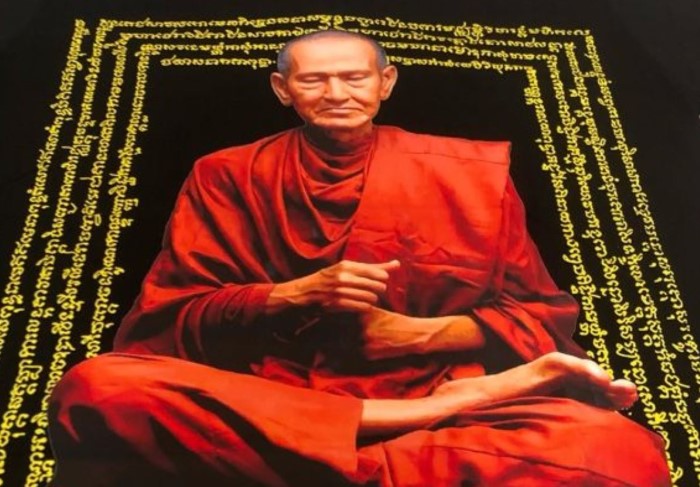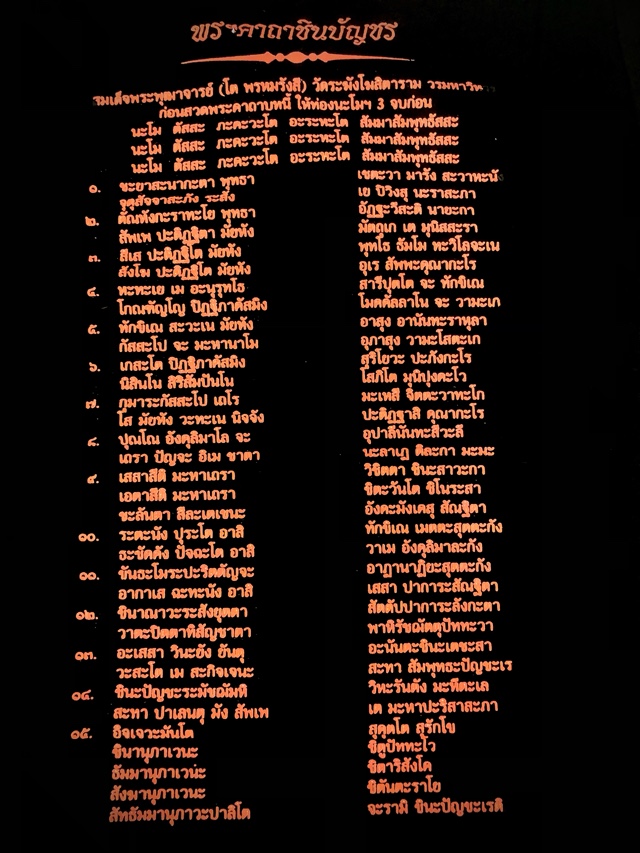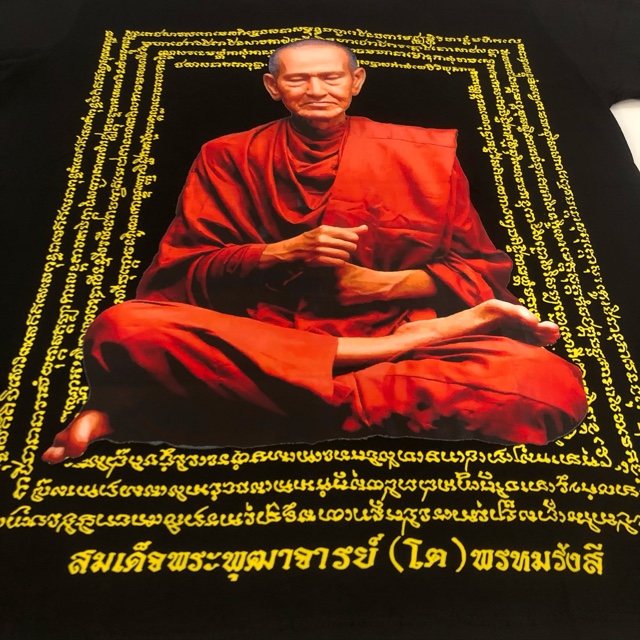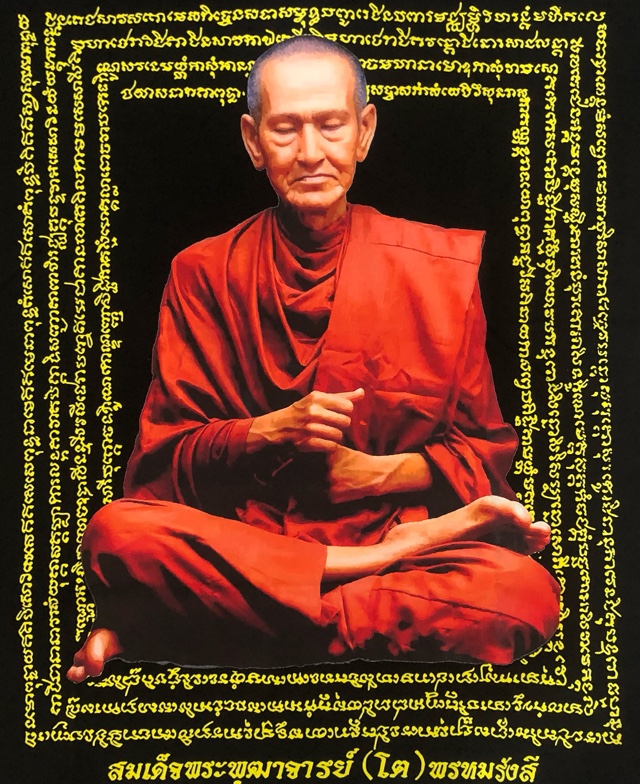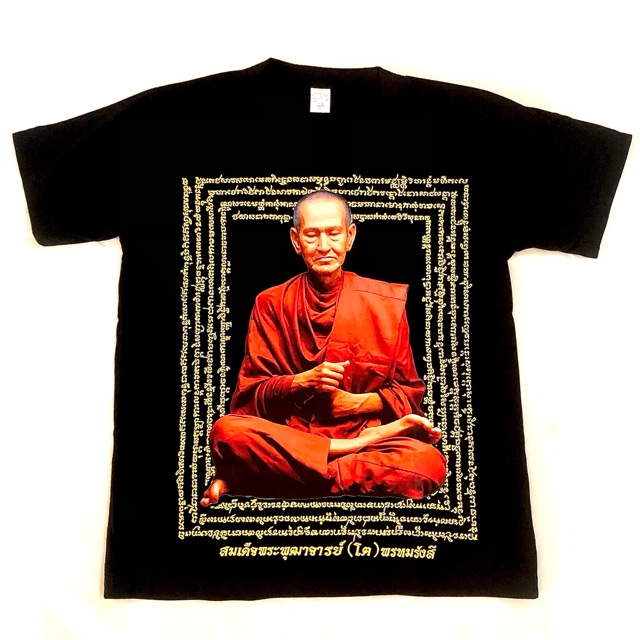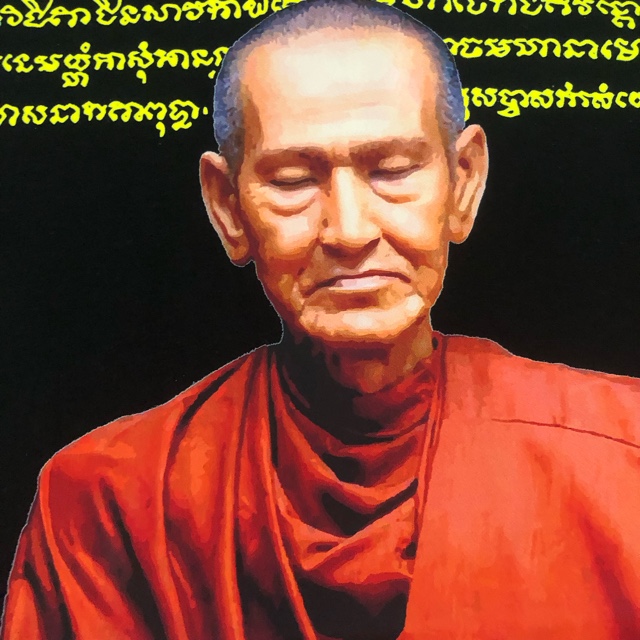High Quality Cotton T-Shirt in color Silk Screen Print on Cotton, emblazoned with the Sacred Image of the Great Thai Master Monk, Somdej Pra Puttajarn (Dto) Prohmrangsri, of Wat Rakang Kositaram, bearing the Kata Chinabanchorn Prayer as an Incantation inscribed on the back of the T-shirt.
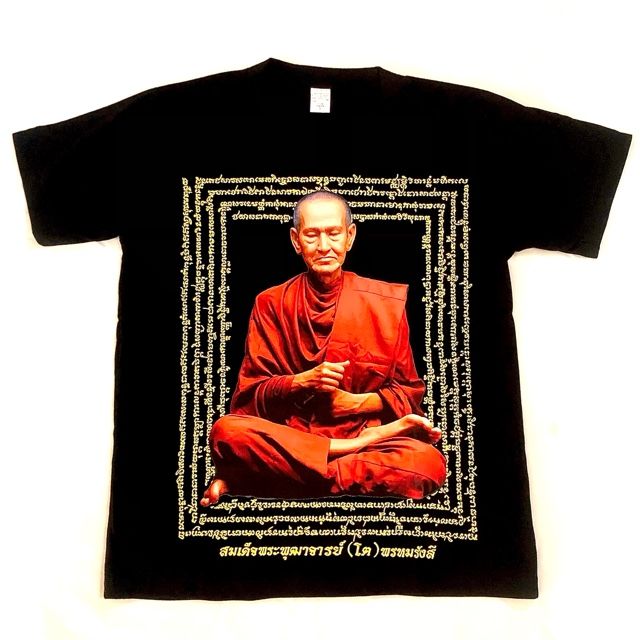
Somdej Pra Puttajarn (Dto) Prohmrangsri, widely known as Somdej Dto, Hlwong Por Dto, or Maha Dto, is one of Thailand’s most revered monks and the creator of the illustrious Pra Somdej amulets. Born on the 17th of April in 2331 BE (1778 CE) during the reign of King Rama I, in Ban Tambon Gai Jon, Ta Ruea, Pra Nakorn Sri Ayuttaya, Somdej Dto’s legacy encompasses both spiritual and material realms, leaving an indelible mark on Thai Buddhism and culture.
The rear face of the shirt bears the sacred Prayer of Kata Chinabanchorn of Somdej Dto
The Kata Chinabanchorn, attributed to the venerable Somdej Pra Puttajarn (Dto) Prohmrangsri of Wat Rakang Kositaram, holds a sacred place in the hearts of Thai Buddhists. This powerful mantra is renowned for its protective qualities and is chanted widely across Thailand.
The legend of the Kata Chinabanchorn begins with Somdej Dto’s journey to Gampaeng Paetch to visit relatives. During this visit, he stopped by an ancient temple named Wat Sadet, located near the Bping River. There, a Chedi (stupa) containing Buddha relics was discovered. Inside this Chedi, an ancient Kampir (grimoire) written in Singhala was found and given to Somdej Dto.
He brought this text back to his Guti (monastic residence) at Wat Rakang. That very night, around 3 a.m., Somdej Dto experienced a Nimitta (vision) of a tall young man with sharp eyes and a white robe standing at the foot of his bed. Recognizing that this was no ordinary human, Somdej Dto engaged in Samadhi meditation and sought to understand the significance of the vision (doc_1).
The Kata Chinabanchorn is one of the signature works of Somdej Dto and is surrounded by a rich tapestry of legends. It is a mantra deeply revered for its sacred power and is one of the top five prayers chanted by Thai Buddhists. The foundation of the Kata Chinabanchorn refers to the group of 28 Buddhas and the names of the fifteen Arahant Savaka (disciples) of Lord Buddha Sakyamuni. The Kata is composed as a seven-verse set, known as the ‘Jed Dtamnan,’ aimed at protecting those who chant it with faithful diligence.
The origins of the Kata Chinabanchorn are a matter of some debate. While it is widely believed that Somdej Dto composed this Kata, some scholars and practitioners remain uncertain. There are claims that another Pra Thaera (elder monk) from Chiang Mai might have originally composed the Kata. Despite these uncertainties, the Kata’s widespread use and reverence remain unquestioned. The Kata has been printed in numerous editions and versions over the years, and its authenticity has been a topic of scholarly examination.
One notable figure in the history of the Kata Chinabanchorn is Jao Prakhun Somdej Prayan Sangworn Jaroen Suwattano of Wat Boworniwes. He played a pivotal role in preserving and publishing new copies of the Kata. In 2503 BE (1961 CE), a monk presented him with a book of prayers from Sri Lanka titled ‘The Mirror of Dhamma,’ which contained the Kata Chinabanchorn. This book used both Singhala and Roman characters with English translations, indicating the Kata’s widespread recognition across different cultures and languages.
Interestingly, the Kata Chinabanchorn is not unique to Thailand. In 2528 BE, Jao Prakhun Somdej Prayan Sangworn met with Pra Tammananta Thaera, a Burmese monk from Wat Ta Ma-O in Lampang. Pra Tammananta Thaera revealed that the Kata Chinabanchorn was also chanted in Burma, primarily for protection against dangers and evil. This highlights the Kata’s significance and its role as a common prayer in various Buddhist traditions.
The Kata Chinabanchorn of Somdej Dto is one of the most important Mantras to use in prayer for many Thai Buddhists, and a profound and sacred mantra with a storied history. It embodies the spiritual legacy of Somdej Pra Puttajarn (Dto) Prohmrangsri and continues to be a vital part of Thai Buddhist practice. Whether chanted for protection, reverence, or spiritual upliftment.
Somdej Dto’s early life was marked by his ordination and subsequent adoption of the name “Prohmrangsri.” His journey in the monastic life was characterized by his deep commitment to the Buddha-Dhamma and his profound understanding and practice of Vipassana mindfulness. His spiritual prowess and dedication to the Buddhist teachings soon earned him a significant following. However, it was his creation of the Pra Somdej amulets that cemented his legacy in the annals of Thai history.
The Pra Somdej amulets of Somdej Dto, particularly those from Wat Rakang Kositaram, Wat Bang Khun Prohm, and Wat Gaes Chaiyo, are considered the “King of Thai amulets.” These sacred objects are not only revered for their spiritual potency but also for their historical and monetary value, with some fetching prices as high as fifty million baht. The amulets are renowned for their various “Pim” (pressings/editions), including the popular “Pim Pra Pratan,” “Pim Ges Bua Dtum,” “Pim Chedi,” “Pim Thaan Saem,” and “Pim Brok Po.”
The legend of Somdej Dto is filled with tales of miraculous events and profound wisdom. One of the most enduring stories is about the making of the Pra Somdej amulets. It is said that Somdej Dto meticulously crafted these amulets using a secret formula that included sacred powders, herbs, and relics. The process was imbued with deep spiritual rituals and blessings, making each amulet a powerful conduit of protection and good fortune for its bearer.
One notable episode in Somdej Dto’s life involves the creation and placement of amulets in the Chedi Gru at Bang Khun Prohm between 2411 and 2413 BE. These amulets were made following the traditional formula and were intended to embody the essence of the Buddha’s teachings. The exact dates of this event are a subject of some debate, with different sources providing varying timelines. However, what remains undisputed is the spiritual significance of these amulets and their continued reverence by devotees.
Somdej Dto’s amulets are not only prized for their spiritual benefits but also for their intricate craftsmanship. Collectors and aficionados of Pra Somdej amulets often emphasize the importance of recognizing the age and contents of the Muan Sarn (sacred material) rather than merely judging by appearance. Authenticating these amulets requires a deep familiarity with the various aging results and the ability to distinguish genuine pieces from imitations.
Despite the widespread fame and high monetary value of his amulets, Somdej Dto’s life was marked by humility and devotion. His teachings and practices emphasized the importance of mindfulness, compassion, and adherence to the Dhamma. He was a guiding light for many, and his legacy continues to inspire generations of Buddhists and spiritual seekers.
The legend of Somdej Pra Puttajarn (Dto) Prohmrangsri is one of great spiritual wisdom, miraculous occurrences, and profound influence on Thai Buddhism. His creation of the Pra Somdej amulets were a way for devotees to connect to his spiritual prowess and they continue to be a source of inspiration and reverence to Thai Buddhists to this very day, and will continue to do so for far into thee future. The amulets, much like Somdej Dto himself, transcend the material realm, embodying the timeless essence of the Buddha’s teachings and the enduring power of faith.
Somdej Dto’s Pra Somdej amulets are considered highly significant in Thai Buddhism, due to their spiritual potency, historical value, and monetary worth. These amulets are believed to possess the following characteristics:
Spiritual potency: Somdej Dto’s amulets are said to be imbued with the spiritual energy of the monk, which is believed to provide protection, blessings, and good fortune to the wearer.
Historical significance: The amulets are a testament to Somdej Dto’s spiritual prowess and his role as a revered Buddhist monk in Thai history.
Monetary value: Some Pra Somdej amulets, particularly those from Wat Rakang Kositaram, are highly valuable and can fetch prices as high as fifty million baht.
Rarity: The amulets are rare and difficult to obtain, making them highly sought after by collectors and devotees.
Association with Somdej Dto: The amulets are closely associated with Somdej Dto, a highly revered Buddhist monk, which adds to their significance and value.
Connection to the Buddha’s teachings: The amulets are believed to embody the essence of the Buddha’s teachings and are considered a powerful tool for spiritual growth and development.
